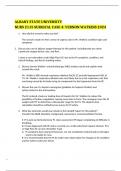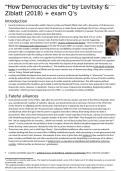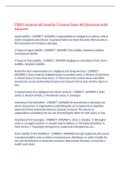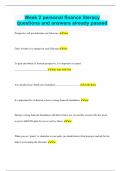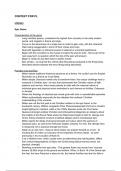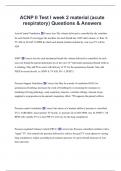HC1 Patient centered care delivery
Overall well-being
Physical well-being: Comfort, stimulation
Social well-being; Affection, behaviour confirmation, status
Activities, resources, healthcare services
Person centered care/patient centered care.
Providing care that is respectful of and responsive to individual patient preferences, needs,
and values and ensuring that patient values guide all clinical decisions.
Organizing person centered care
- Patient preferences
- Information and education
- Access to care
- Physical comfort
- Emotional support
- Family and friends
- Coordination of care
- Continuity and transition
8 different dimensions to define person centered care.
1. Patient preferences: It is important to stimulate patients to set goals. It takes a lot of
time to know the preferences of the patients.
2. Information and education: It is important to know the whole aspects of care. You
should do this regardless language barriers.
3. Access to care: health care organizations should be accessible.
4. Physical comfort: we pay attention for the physical effects of having a disease or an
illness. It is also the physical comfort delivered by the health care organization:
privacy, hygiene.
5. Emotional support: Anxiety or depression due to the disease. It is important that a
health care organization pays attention to these emotional consequences.
6. Family and friends: The support of family and friends.
7. Coordination of care: within one health care organization.
8. Continuity and transition: When multiple health care organizations are involved.
Patient: differences in patient needs and healthy literacy. The health care organization must
decide what is the best for the patients.
Organization: Differences in education, motivation, and skills of healthcare
professionals/organizations. In order to deliver patient centered care, the organization
should be motivated to engage the different dimensions.
,National: restrictive information sharing and a lack of supportive financial structures. Not all
the information systems work together. Due to privacy laws do not all the information
systems work together. There are financial barriers.
You always come back to the 8 dimensions.
Person centered care for people living with obesity.
- More than the half of the population is overweight. The amount of people with
obesity is increasing.
Underlying causes of obesity in adults
- Genetic or syndromic: defect or deficiency, leptin
- Hypothalamic Post surgery, therapy
- Endocrine; post pregnancy, weight retention
- Medication: antidepressants, antipsychotics, anti-epileptics
- Mental disorders: Binge eating disorders, depression, bulimia.
- Lifestyle: Hypercaloric intake, lack of exercise.
The eight dimensions in relation to obesity
Patient preferences; Individual treatment
Information and education: Mostly the information doesn’t match the information that
patients need.
Access to care: Lack of training.
Physical comfort: Respiratory issues, skin conditions.
Emotional support: Weight-related bias and discrimination.
Family and friends; Lack of support from others. It can be important to inform others.
Coordination of care:
Continuity and transition:
Benefits of patient centered care
- Greater satisfaction with care
- Higher well-being
Weight stigma
= Discrimination or bias towards individuals because of their weight or size.
- Also prevalent in healthcare settings
- A barrier to the provision of PCC for patients living with obesity.
- Patients are getting less time when in healthcare organization.
- They experience increased stress.
,Literature theme 1:
Rathert:
PCC encompasses providing care that is compassionate, empathetic, and responsive to the
needs, values, and expressed preferences of each individual patient. Patients should be
informed decision makers in their care. Patients define PCC in terms of eight dimensions:
respect for patient preferences, values and expressed needs. 2.Information, education, and
communication 3. Coordination and integration of care and services 4. Emotional support 5.
Physical comfort 6. Involvement of family and close others 7. Continuity and transition from
hospital to home 8. Access to care and services.
Jayadevappa:
Patient centered care encompasses informed decision making and can improve treatment
choice, quality of care and outcomes. Patient-centered care recognizes the needs for major
changes in the process of care that arranges health care system around the patient. PCC is
associated with quality of care. PCC can have important benefits for the patients through
improved communication, appropriate outcomes. PCC implies individualized patient care
based on patient-specific information. PCC is known as patient-centered approach or patient-
focused care. PCC requires changes in the healthcare system from reimbursement process to
discharge planning and social environment. Enhancing decision quality may require
systematic changes in the healthcare system that can lead to incorporation of shared
decision-making interventions into routine care and realignment of financial incentive to
reward providers who foster and support high-quality patient centered decision-making. It
should also value the kind of physician-patient interactions that can lead to more patient-
centered care. This may lead to improved overall quality of care by minimizing wasteful
health resource consumption that have little or no benefit to the patient.
Naomi L Lacy
The study’s purpose was to identify the elements of a definition of evidence-bsaed patient-
centered care (EBPCC), the barriers for using it, and the strategies for overcoming these
barriers.
Conceptual models
, In the either/or model of evidence-based and patient-centered care: each approach was
distinct from the other.
Continuum model: In a continuum model, EBPCC ranged from purely evidence based to
purely patient centered. This model suggests a point at which a clinician incorporated both
patient centeredness and evidence-based medicine and that the best practice involved
balancing the two. Somewhere in the middle is where good care occurs. Part of what make
good practice is balancing and weighing the population risk with the individual’s value of
those risks.
Cyclical:
Depending on the interaction behind the patient, one may bounce back and forth. EBPCC is
in this model a process that moves from patient-centered care through evidence-based care
and then back to patient-centered care. The cyclical model differs in that is does not focus as
much on integration as using both methods, alternating between EBM and PCC tasks and is
inherently more dynamic.
Integrated model:
Group members conceptualized overlapping spheres, creating a bang of practice in which the
practitioners apply concepts from both spheres. The intersection of the spheres is where
integration occurred.
The principal barriers appear to be related to time restraints, relational challenges, and
finding common ground. Participants did not have well-developed strategies to overcome
these barriers. The participants discussed the need to continually improve patient outcomes
and described EBPCC as a journey.
Kuipers:
PCC has the potential to entail tailored primary care delivery according to the needs of
patients with multimorbidity. To make primary care for these patients more patient-centered,
insight on healthcare professionals perceived PCC implementation barriers is needed.
Barriers were identified in all eight dimensions. They include difficulties achieving mutual
understanding between patients and healthcare professionals, the lack of training and
education in new skills, data protection laws that impede adequate documentation and
information sharing, time pressure, and conflicting financial incentives.
According to the eight dimensions framework, PCC delivery to patients with multimorbidity
requires healthcare professionals to support patients in the setting and achievement of
treatment goals guided by patient preferences. Patients with multi-morbidity can be viewed
as being experts on their diseases who should be empowered by healthcare professionals to
be in charge of their own care. Health care professionals should provide information and
education that is accessible and understandable to all. PCC empathizes the need for good
access to care, affordability and the accessibility of buildings to all patients. Having many
chronic conditions is often accompanied by physical problems, therefore attention should be
paid to patients’ physical comfort because the perceived quality of physical comfort affects
the perceived quality of care. To be patient centered, healthcare professionals should offer
emotional support to patients and family and friends. Besides, care delivery to patients with
Overall well-being
Physical well-being: Comfort, stimulation
Social well-being; Affection, behaviour confirmation, status
Activities, resources, healthcare services
Person centered care/patient centered care.
Providing care that is respectful of and responsive to individual patient preferences, needs,
and values and ensuring that patient values guide all clinical decisions.
Organizing person centered care
- Patient preferences
- Information and education
- Access to care
- Physical comfort
- Emotional support
- Family and friends
- Coordination of care
- Continuity and transition
8 different dimensions to define person centered care.
1. Patient preferences: It is important to stimulate patients to set goals. It takes a lot of
time to know the preferences of the patients.
2. Information and education: It is important to know the whole aspects of care. You
should do this regardless language barriers.
3. Access to care: health care organizations should be accessible.
4. Physical comfort: we pay attention for the physical effects of having a disease or an
illness. It is also the physical comfort delivered by the health care organization:
privacy, hygiene.
5. Emotional support: Anxiety or depression due to the disease. It is important that a
health care organization pays attention to these emotional consequences.
6. Family and friends: The support of family and friends.
7. Coordination of care: within one health care organization.
8. Continuity and transition: When multiple health care organizations are involved.
Patient: differences in patient needs and healthy literacy. The health care organization must
decide what is the best for the patients.
Organization: Differences in education, motivation, and skills of healthcare
professionals/organizations. In order to deliver patient centered care, the organization
should be motivated to engage the different dimensions.
,National: restrictive information sharing and a lack of supportive financial structures. Not all
the information systems work together. Due to privacy laws do not all the information
systems work together. There are financial barriers.
You always come back to the 8 dimensions.
Person centered care for people living with obesity.
- More than the half of the population is overweight. The amount of people with
obesity is increasing.
Underlying causes of obesity in adults
- Genetic or syndromic: defect or deficiency, leptin
- Hypothalamic Post surgery, therapy
- Endocrine; post pregnancy, weight retention
- Medication: antidepressants, antipsychotics, anti-epileptics
- Mental disorders: Binge eating disorders, depression, bulimia.
- Lifestyle: Hypercaloric intake, lack of exercise.
The eight dimensions in relation to obesity
Patient preferences; Individual treatment
Information and education: Mostly the information doesn’t match the information that
patients need.
Access to care: Lack of training.
Physical comfort: Respiratory issues, skin conditions.
Emotional support: Weight-related bias and discrimination.
Family and friends; Lack of support from others. It can be important to inform others.
Coordination of care:
Continuity and transition:
Benefits of patient centered care
- Greater satisfaction with care
- Higher well-being
Weight stigma
= Discrimination or bias towards individuals because of their weight or size.
- Also prevalent in healthcare settings
- A barrier to the provision of PCC for patients living with obesity.
- Patients are getting less time when in healthcare organization.
- They experience increased stress.
,Literature theme 1:
Rathert:
PCC encompasses providing care that is compassionate, empathetic, and responsive to the
needs, values, and expressed preferences of each individual patient. Patients should be
informed decision makers in their care. Patients define PCC in terms of eight dimensions:
respect for patient preferences, values and expressed needs. 2.Information, education, and
communication 3. Coordination and integration of care and services 4. Emotional support 5.
Physical comfort 6. Involvement of family and close others 7. Continuity and transition from
hospital to home 8. Access to care and services.
Jayadevappa:
Patient centered care encompasses informed decision making and can improve treatment
choice, quality of care and outcomes. Patient-centered care recognizes the needs for major
changes in the process of care that arranges health care system around the patient. PCC is
associated with quality of care. PCC can have important benefits for the patients through
improved communication, appropriate outcomes. PCC implies individualized patient care
based on patient-specific information. PCC is known as patient-centered approach or patient-
focused care. PCC requires changes in the healthcare system from reimbursement process to
discharge planning and social environment. Enhancing decision quality may require
systematic changes in the healthcare system that can lead to incorporation of shared
decision-making interventions into routine care and realignment of financial incentive to
reward providers who foster and support high-quality patient centered decision-making. It
should also value the kind of physician-patient interactions that can lead to more patient-
centered care. This may lead to improved overall quality of care by minimizing wasteful
health resource consumption that have little or no benefit to the patient.
Naomi L Lacy
The study’s purpose was to identify the elements of a definition of evidence-bsaed patient-
centered care (EBPCC), the barriers for using it, and the strategies for overcoming these
barriers.
Conceptual models
, In the either/or model of evidence-based and patient-centered care: each approach was
distinct from the other.
Continuum model: In a continuum model, EBPCC ranged from purely evidence based to
purely patient centered. This model suggests a point at which a clinician incorporated both
patient centeredness and evidence-based medicine and that the best practice involved
balancing the two. Somewhere in the middle is where good care occurs. Part of what make
good practice is balancing and weighing the population risk with the individual’s value of
those risks.
Cyclical:
Depending on the interaction behind the patient, one may bounce back and forth. EBPCC is
in this model a process that moves from patient-centered care through evidence-based care
and then back to patient-centered care. The cyclical model differs in that is does not focus as
much on integration as using both methods, alternating between EBM and PCC tasks and is
inherently more dynamic.
Integrated model:
Group members conceptualized overlapping spheres, creating a bang of practice in which the
practitioners apply concepts from both spheres. The intersection of the spheres is where
integration occurred.
The principal barriers appear to be related to time restraints, relational challenges, and
finding common ground. Participants did not have well-developed strategies to overcome
these barriers. The participants discussed the need to continually improve patient outcomes
and described EBPCC as a journey.
Kuipers:
PCC has the potential to entail tailored primary care delivery according to the needs of
patients with multimorbidity. To make primary care for these patients more patient-centered,
insight on healthcare professionals perceived PCC implementation barriers is needed.
Barriers were identified in all eight dimensions. They include difficulties achieving mutual
understanding between patients and healthcare professionals, the lack of training and
education in new skills, data protection laws that impede adequate documentation and
information sharing, time pressure, and conflicting financial incentives.
According to the eight dimensions framework, PCC delivery to patients with multimorbidity
requires healthcare professionals to support patients in the setting and achievement of
treatment goals guided by patient preferences. Patients with multi-morbidity can be viewed
as being experts on their diseases who should be empowered by healthcare professionals to
be in charge of their own care. Health care professionals should provide information and
education that is accessible and understandable to all. PCC empathizes the need for good
access to care, affordability and the accessibility of buildings to all patients. Having many
chronic conditions is often accompanied by physical problems, therefore attention should be
paid to patients’ physical comfort because the perceived quality of physical comfort affects
the perceived quality of care. To be patient centered, healthcare professionals should offer
emotional support to patients and family and friends. Besides, care delivery to patients with

